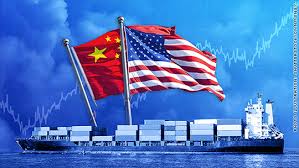Trump Thinks He Is Winning the Trade War. The Data Tell a Different Story

Talk to anyone in Trumpland, and you’ll hear that America is winning the trade war. “The economic burden is falling vastly more on them than on us,” proclaimed the President’s chief economic adviser Larry Kudlow in early August as the conflict escalated. But if you look past the rhetoric and crunch the numbers, a strikingly different picture emerges. The more Trump ratchets up tensions, the more he hurts the U.S. economy. By forcing U.S. companies and consumers to pay far more for everything from sneakers to steel, Trump is inflicting a heavy price that could plunge the country into recession.
There are two issues: First, the way the President has structured his tariffs is creating what economists refer to as “deadweight” losses that threaten GDP growth (more on that later). Second, China has cannily avoided such pitfalls by being far more judicious in its tariff strategy.
Take Trump’s latest round of tariffs, slated to take effect at the start of September. Those new duties target for the first time a wide swath of consumer goods, some $ 300 billion in toys, footwear, apparel, and some tech gear (Trump has delayed some levies till December). The new categories will be hit with tariffs just in time for holiday shopping.
According to a recent study from researchers at the New York Federal Reserve, Columbia, and Princeton, in 2018, U.S. domestic prices rose “one-to-one with tariffs levied in that year.” And contrary to what some Trump economists have claimed, “Chinese exporters did not reduce their prices.”
That’s leading to what Stephen Redding, the Princeton economist who coauthored the study, calls “deadweight” losses. Those are the extra costs that producers incur—and customers pay—for goods they used to purchase from China but now buy from third countries, where the U.S. gets no tariff revenue.
“Deadweight” losses are the extra costs producers and consumers pay for goods they used to purchase from China but now buy from other countries.
For example, GoPro is shifting most of its U.S.-bound production from China to Mexico by mid-2019, while Hasbro is moving much of its sourcing of toys sold stateside from China to Vietnam and India, citing Trump’s tariffs. Levi Strauss, Gap, and shoe company Steve Madden have all announced plans to buy less from China and more from nations such as Vietnam and Bangladesh.
Here’s the rub: When those companies were producing in China and paying a 25% tariff on goods, they typically added that charge to their prices. The U.S. government collected that levy and could cycle it into the economy by funding anything from aid to farmers (some $ 12 billion in 2018) to military salaries to highways. But as tariffs get bigger and bigger, the incentive rises for companies to shift from Chinese suppliers to other countries where they might be overpaying by 10%, 15%, or even 20%. “Now, they’re shifting to producers who are costlier and less efficient, hindering the efficiency of the U.S. economy,” says Chad Bown, an economist at the Peterson Institute.
How big is the deadweight burden? The N.Y. Fed study calculated that every U.S. household is paying an extra $ 620 a year. That number could double if Trump raises tariffs on all Chinese imports to 25%. The cumulative hit to GDP, when you include the drop in exports to China, could be $ 200 billion, says Weijian Shan, the Ph.D. economist who heads Hong Kong private equity giant PAG, and is the author of Out of the Gobi: My Story of China and America.
That’s a gigantic number. After expanding at 2.9% last year, GDP growth decelerated to 2.1% in the second quarter, and the Congressional Budget Office predicts an expansion of just 1.7% in 2020. At that rate, real GDP would increase less than $ 400 billion next year, so a $ 200 billion drag would cut growth in half, to around 1% or less. A drop that size means tepid or zero job creation, flagging investment, and slumping profits—and raises the odds that the economy could tip into recession.
Meanwhile, China too has paid a price—albeit a smaller one. The IMF predicts GDP expansion of just 6.2% this year, the lowest number since 1990, and 6.0% in 2020. But instead of slapping one-size-fits-all tariffs across vast categories of goods, Xi Jinping is targeting only products the country can’t buy at comparable cost elsewhere. For example, China has imposed a 28% levy on 100% of the $ 13.9 billion in soybeans it used to buy from the U.S. because it can acquire them at about the same price from Brazil and Argentina. But it can’t find good substitutes for American-made aircraft, drugs, or cars, so China has kept tariffs on those products near pre–trade war levels. Duties on U.S. pharmaceuticals and planes remain below 3%.
At the same time, China has lowered tariffs on every other country. So in most categories, U.S. exporters now face higher tariffs and tougher competition from Canadian, European, and Japanese suppliers.
Crunch the numbers, and it’s hard to come to any other conclusion: In the trade war that will chart America’s economic future, China is winning.
A version of this article appears in the September 2019 issue of Fortune with the headline “The True Cost of the Trade War.”
More must-read stories from Fortune:
—Trump ties Hong Kong protests to China trade deal in a move that could backfire
—China has reached parity with the U.S. on the 2019 Fortune Global 500
—China’s biggest private sector company is betting its future on data
—Boxed in at the docks: How a lifeline from China changed Greece
—Listen to our audio briefing, Fortune 500 Daily
